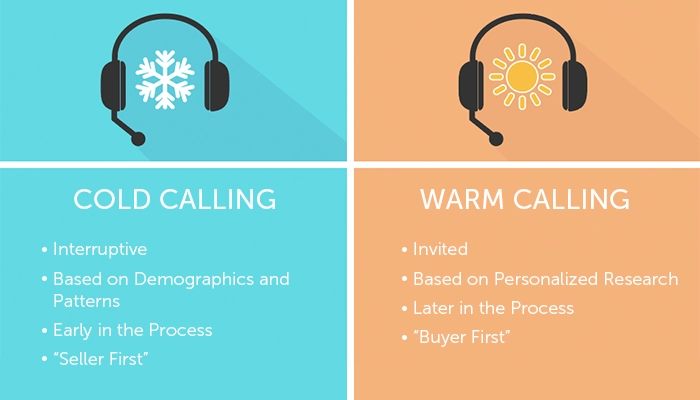When it comes to relationships, most are like coffee – the warmer, the better!
That’s definitely the case when you want to connect with a decision maker by phone.
For decades, cold calling was seen as one of the most powerful tools in any sales pro’s kit. However, even in its heyday, cold calling had a dark side.
It took up a tremendous amount of time and energy for seller and prospective buyer alike. And, the average salesperson dreaded making those calls and the average buyer dreaded receiving them. It’s a lose-lose situation.
A tiny handful of sales experts may have built successful businesses on the back of cold calling, but for each one who did, there were hundreds or thousands who simply wasted their time.
Today, cold calling is being supplanted by a much more valuable alternative: Warm calling.
What Is Warm Calling?
Warm calling is an approach to prospecting that puts relationship-building first by highlighting common interests.
When you come in cold, you are asking someone who has never heard of you before to sacrifice an uncertain amount of their time for a conversation they have no reason to look forward to.
On the other hand, warm calling ensures a prospect has an enticing taste of the value you can offer.
When companies embrace warm calling along with an end-to-end inbound marketing strategy, they build deeper customer relationships on a foundation of respect.
Warm Calling vs. Cold Calling: What’s the Difference?
It’s not just a temperature thing.
Cold calling and warm calling fall on completely different sides of the spectrum when it comes to prospecting. Here’s some of the biggest differences:

Interruptive vs. Invited
This is the biggest thing that distinguishes a cold call: It’s an interruption.
The seller picks out a name, dials a number, and expects to be patched through immediately. Attempts to find the “best day” to make a call hardly softens the underlying assumption that others owe you their time.
Unlike cold calls, the best warm calling comes
after buyers show an interest in what you offer. Ideally, this means a personal recommendation from someone they trust – but that’s not the only way. Buyers often signal interest when interacting with your content.
For example, if someone downloads The Ultimate Blogging Checklist offer, they have signaled a pain. They want to start blogging, or they’re interested in what’s needed to start blogging efficiently.
Demographics and Patterns vs. Personalized Research
Cold calling is usually adopted as a way to hurry through the sales process as quickly as possible.
To capitalize on the expected time savings, cold callers generally look at statistics like company size, industry, region, and recent buys. They know little (or nothing) about the individual buyer.
With warm calling, you use personal insight to create a genuine connection with a buyer.
You can see what pages on your website he or she has read, for example. Researching the challenges and opportunities confronting the prospect can help you foster trust.
Early in the Process vs. Later in the Process
The theory behind cold calling is that you can “drum up” business.
Cold callers don’t really expect to connect with someone interested in a solution like theirs: Instead, they want to create a desire that’s not there. Thus, cold calling is early in the sales process … often, step zero.
On the other end, warm calling is a natural outgrowth of an ongoing relationship with your brand. It’s up to you to find the
sweet spot where prospects know a bit about you and are ready to have a meaningful conversation.
“Seller First” Worldview vs. “Buyer First” Worldview
Cold calling is all about the seller’s needs. If you’re not interested in a given solution – or don’t even think you have a problem – that’s ok.
As long as you fit the profile, you are a prospective buyer, and the seller will do everything possible to exhaust (“overcome”) your objections.
The final goal of warm calling is to motivate sales, of course, but the strategy is very different.
When you warm call, you acknowledge not everyone is a good customer for you. Open-ended questions and active listening are crucial to truly hear what buyers have to say.
Source: https://www.business2community.com/sales-management/7-warm-calling-tips-guaranteed-to-get-your-prospects-talking-02315583


